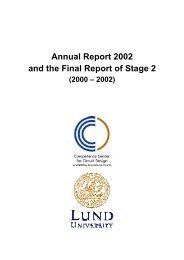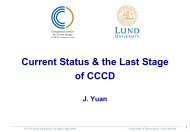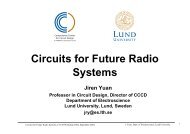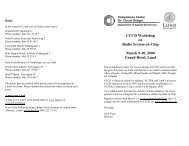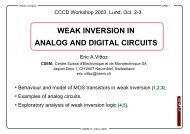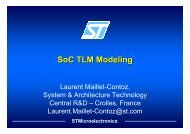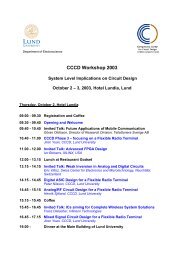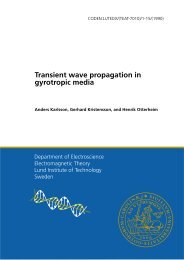Design of Antennas for Handheld DVB-H ... - Lunds tekniska högskola
Design of Antennas for Handheld DVB-H ... - Lunds tekniska högskola
Design of Antennas for Handheld DVB-H ... - Lunds tekniska högskola
Create successful ePaper yourself
Turn your PDF publications into a flip-book with our unique Google optimized e-Paper software.
not be possible, there will always be some delay. This is <strong>for</strong> instance not wanted<br />
when a live football match is transmitted.<br />
Other notable differences between <strong>DVB</strong>-H and <strong>DVB</strong>-T are MPE-FEC and 4kmode.<br />
These features are added to <strong>DVB</strong>-H to make the system more robust and to<br />
make the network design more flexible. They have no major drawbacks but when<br />
MPE-FEC is used more bits have to be sent per data bit.<br />
The <strong>DVB</strong>-H system suits handheld terminals very well in all ways except that a<br />
normal sized antenna <strong>for</strong> the frequencies used would be larger than the terminal<br />
itself. The large bandwidth that the antenna has to cover is a hard problem to<br />
solve. We have solved this problem in three different ways, with one wideband,<br />
one switched and one tunable narrowband antenna. The different solutions fit<br />
different kinds <strong>of</strong> terminals. Since the wideband antenna, folded-patch, is<br />
sensitive to interference this solution fits best in devices without GSM 900, like<br />
Ipod and other terminals with screens suitable <strong>for</strong> watching TV. From this point <strong>of</strong><br />
view the loop antenna is the most suitable antenna <strong>for</strong> GSM 900 terminals.<br />
Theoretically the isolation between an H-field and an E-field antenna is much<br />
higher than <strong>for</strong> two E-field antennas. This theory and its narrowband characteristic<br />
are two things that make the loop antenna interference tolerant. No tests have been<br />
done to find out which <strong>of</strong> these things that contributes most to the interference<br />
tolerance. A lot <strong>of</strong> discussions with senior antenna designers about the H- and Efield<br />
theory have been conducted. None <strong>of</strong> these designers could say <strong>for</strong> sure that<br />
this theory has any effect in the real case. If the folded patch should be used in a<br />
GSM 900 terminal a good filter on the <strong>DVB</strong>-H chipset is required. As an example,<br />
if the maximum allowed input level <strong>of</strong> the <strong>DVB</strong>-H chipset is –28 dBm the total<br />
attenuation (isolation + filter) must be at least 61 dB (since a GSM 900 terminal<br />
transmits with a peak value <strong>of</strong> 33 dBm). The requirement <strong>of</strong> the filter depends on<br />
the antenna used since the isolation between the GSM 900 antenna and the <strong>DVB</strong>-<br />
H antenna will differ.<br />
If the mobile manufacturers desire an embedded antenna the only suitable solution<br />
would be the switched monopole 2.This is the major advantage with this solution<br />
compared to the other two that needs an extension. Customers today are used to<br />
embedded antennas and do not prefer an external solution that easily breaks. If an<br />
external solution is chosen anyway it could be combined as a support <strong>for</strong> the<br />
terminal to be able to stand on a table or another smart mechanical solution.<br />
Regardless <strong>of</strong> which antenna that is selected an important thing is the placement<br />
<strong>of</strong> the antenna element. It has to be placed so that the antenna characteristics are<br />
changed as little as possible when the user holds the terminal in different ways.<br />
75



